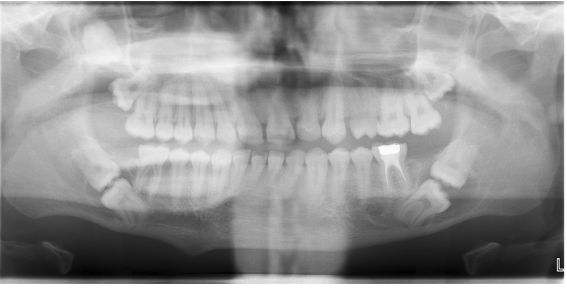An interesting article titled “Bilateral ‘kissing’ molars: A case report” appears in Clinical Case Reports written by Bilal Aslam- Pervez and Emma Carr (2022;10:e06407). The article discusses a case of a 20 year old man who had a very rare bilateral kissing molars impaction. Kissing molars occur the occlusal surfaces of impacted molars are united by the same follicular space and the roots point in the opposite direction. This typically occurs between wisdom teeth and second molars, but can also occur between wisdom teeth and the fourth molar.
In the article discussion is made of the 20 year old man who went to a hospital in Scotland complaining of a dull ache for the last year. The patient was healthy but did smoke around 10 cigarettes a day for the last few years. Upon examination a total of 7 teeth were noted as not having erupted. A panoramic x-ray of the mouth showed bilateral kissing molars in the lower quadrants linked with cystic lesions encompassing the molar crowns. The man was instructed to get a CBCT to determine potential risks involved with surgical extraction of teeth. Numerous relevant features were noted as described in the article.
The man had a biopsy of the cystic lesion in the lower left quadrant which showed a dentigerous cyst. Several potential treatment options were considered and the man decided he wanted to have his upper right teeth #7 and #8 and the lower kissing molars extracted due to the risk of damage to the man’s inferior alveolar nerves. The man had he surgery performed under general anesthesia. During the surgery the inferior alveolar nerve was not exposed. The man recovered from the surgery without incident using simple analgesics and chlorhexidine use. At a three month follow-up complete soft tissue healing had occurred and the man had no problems.

When discussing the case, the authors mention that the etiology of kissing molars is not known. There are theories that an ectopic tooth bud causes them to develop and that early cystic development around a molar may cause crowns to displace. Kissing molars typically involved lower wisdom teeth impacted against the adjacent second molar. When extracting, there can be a high degree of risk of damage to the inferior alveolar nerves and a cone beam CT can provide information regarding the buccolingual positioning of the inferior alveolar nerveand width of the remaining bone to help avoid injury. Radiographic features which can cause a high risk of inferior alveolar nerve damage are deflection of the roots, narrowing of the roots, diversion of the canal, and narrowing of the canal. When discussing the case the authors state:
“For our patient, the risk of damage to bilateral inferior alveolar nerves was increased due to their close proximity to the second molars. Therefore, following discussion with the patient, it was decided that surgical intervention was only to be carried out in the lower left quadrant where the dentigerous cyst was more advanced and presented a higher risk of infection due to its oral communication.”
The authors mention that kissing molars can be monitored instead of extracted but the patient should weigh the risks of nearby root resorption and cyst formation against the risks of surgical intervention. The authors feel that kissing molars should be considered on a case by case basis. They hope that in the future research can be conducted to better understand the etiology of the kissing molars.
